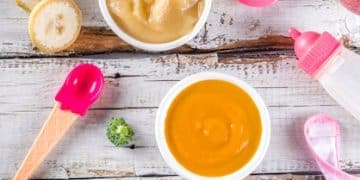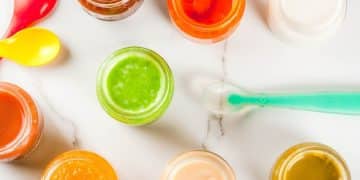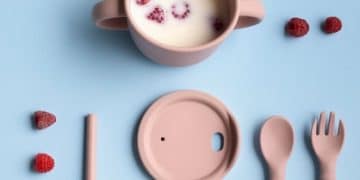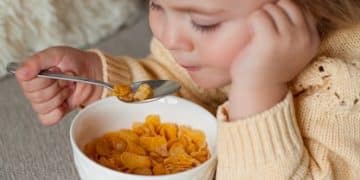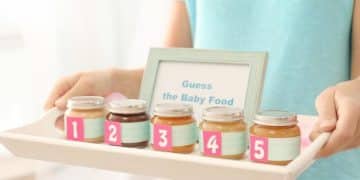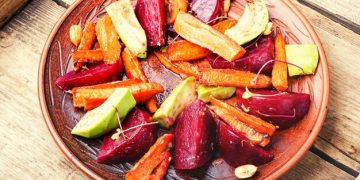Baby Food Storage: Keep Homemade Purees Fresh for 3 Months

Proper baby food storage is crucial for maintaining the nutritional value and safety of homemade purees, allowing you to keep them fresh for up to 3 months with the right techniques.
Preparing homemade baby food ensures that your little one gets the freshest and most nutritious start to their solid food journey. However, understanding baby food storage: how to keep homemade purees fresh for up to 3 months is key to making the most of your efforts and minimizing waste. Here’s a comprehensive guide to help you navigate the world of baby food preservation.
Understanding the Basics of Baby Food Storage
Properly storing baby food is not just about convenience; it’s about ensuring your baby’s health and safety. Understanding the foundational principles will help you avoid spoilage and maintain the nutritional integrity of your homemade creations.
Why Proper Storage Matters
Improperly stored baby food can harbor bacteria or lose essential nutrients, making it less beneficial or even harmful for your baby. Proper storage techniques are vital for preserving the quality and safety of homemade purees.
Key Considerations for Baby Food Storage
Several factors play a role in successful baby food storage, including temperature, container type, and hygiene. Keeping these factors in check is crucial for maintaining the food’s quality and safety.
- Temperature Control: Storing food at the correct temperature prevents bacterial growth.
- Container Selection: Using appropriate containers protects the food from contamination and freezer burn.
- Hygiene Practices: Cleanliness during preparation and storage is paramount to avoid harmful bacteria.
By paying attention to these key considerations, parents can confidently store homemade baby food, knowing they are providing the best and safest nutrition for their little ones. It’s a simple yet crucial step in supporting your baby’s healthy development.
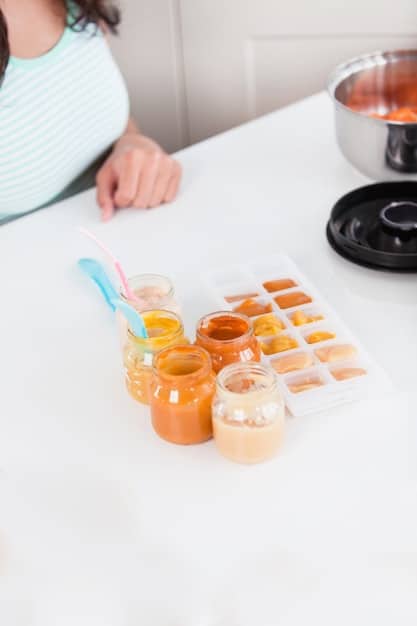
Best Containers for Freezing Baby Food
Choosing the right containers for freezing baby food is crucial for maintaining its quality and preventing freezer burn. Several options are available, each with distinct advantages.
Silicone Trays
Silicone trays, often designed with individual compartments perfect for portioning, are an excellent choice. Once the purees are frozen, the cubes can be easily transferred to freezer bags for longer storage.
Glass Containers
Small, reusable glass containers are another popular option. They are durable, easy to clean, and prevent plastic leaching. Ensure the containers are freezer-safe and leave some headspace to allow for expansion.
- Portion Control: Choose containers that hold single servings to minimize waste.
- Durability: Opt for freezer-safe containers that can withstand low temperatures.
- Easy Cleaning: Select containers that are easy to clean and sterilize.
Ultimately, the best container depends on your personal preferences and priorities. However, paying attention to these factors ensures that your homemade baby food remains fresh, safe, and easily accessible whenever you need it.
Step-by-Step Guide to Freezing Baby Food Purees
Freezing baby food purees correctly ensures that they retain their nutritional value and flavor for an extended period. Here’s a step-by-step guide to help you through the process.
Preparing the Puree
Start by preparing your baby food puree as usual. Ensure all ingredients are fresh, thoroughly washed, and properly cooked. Once pureed, allow the food to cool slightly before proceeding.
Portioning the Puree
Portion the puree into your chosen containers, leaving a little space at the top to allow for expansion during freezing. This helps prevent the containers from cracking or bursting.
Freezing Process
Place the filled containers in the freezer, ensuring they are placed flat to freeze evenly. Once the purees are frozen solid, usually after about 4-6 hours, you can transfer the cubes to freezer bags for better organization.
- Cooling: Avoid freezing hot purees directly to prevent condensation and ice crystal formation.
- Labeling: Always label each container or bag with the date and contents to keep track of freshness.
- Freezing Speed: Freezing the purees quickly helps maintain their texture and flavor.
By following these steps, you can effectively freeze your baby food purees, ensuring they remain fresh and nutritious for up to 3 months. It’s a great way to save time and provide your little one with homemade goodness whenever you need it.
Safe Thawing Methods for Frozen Baby Food
Thawing baby food correctly is as important as freezing it properly. Improper thawing can create an environment for bacteria to thrive. Here are the recommended methods for safely thawing frozen baby food.
Refrigerator Thawing
The refrigerator is the safest place to thaw baby food. Transfer the frozen puree from the freezer to the refrigerator and allow it to thaw overnight. This method ensures a gradual and even thawing process.
Warm Water Bath
For quicker thawing, you can use a warm water bath. Place the sealed container of frozen puree into a bowl of warm water for about 10-20 minutes, changing the water as needed to maintain a consistent temperature. Ensure the water doesn’t get too hot to avoid cooking the food.
Microwave Thawing
While microwave thawing is an option, it’s generally not recommended due to uneven heating. If you must use a microwave, ensure you stir the puree thoroughly after each short burst to distribute the heat evenly and prevent hot spots.
- Avoid Room Temperature Thawing: Never thaw baby food at room temperature, as this encourages bacterial growth.
- Use Immediately: Once thawed, use the baby food immediately and do not refreeze it.
- Check for Consistency: Ensure the thawed puree has a consistent texture and no signs of spoilage before feeding it to your baby.
Ensuring you follow these safe thawing methods, you can confidently prepare and serve your little one delicious and nutritious homemade baby food without compromising on safety.

How Long Does Homemade Baby Food Last?
Understanding the shelf life of homemade baby food is crucial for ensuring your baby’s safety. Knowing how long different storage methods preserve your purees will help you plan and prevent waste.
Refrigerator Storage
Homemade baby food can be stored in the refrigerator for up to 48 hours. Ensure it is kept in an airtight container to maintain freshness and prevent bacterial contamination. Always check for any signs of spoilage before serving.
Freezer Storage
When stored in freezer-safe containers, homemade baby food can last for up to 3 months in the freezer. Labeling each container with the date of preparation will help you keep track of its freshness.
Signs of Spoilage
Before feeding your baby any stored food, always check for signs of spoilage. These can include a sour odor, a change in color or texture, or any visible mold. If you notice any of these signs, discard the food immediately.
- Taste Test: If you’re unsure about the freshness of the food, taste a small amount before feeding it to your baby (but avoid double-dipping).
- Proper Handling: Use clean utensils when serving baby food to prevent contamination.
- Avoid Refreezing: Never refreeze baby food that has already been thawed, as this can significantly increase the risk of bacterial growth.
By being vigilant about storage times and spoilage signs, you can confidently provide your baby with safe and nutritious homemade meals. Proper management ensures your efforts are rewarded with happy and healthy feeding experiences.
Tips for Maximizing Freshness and Reducing Waste
Maximizing the freshness of your homemade baby food and reducing waste is not only cost-effective but also environmentally friendly. Here are some practical tips to help you achieve these goals.
Plan Ahead
Planning your baby’s meals in advance allows you to prepare only what you need, reducing the likelihood of leftovers going to waste. Consider portioning your recipes based on your baby’s appetite and needs.
Batch Cooking
Consider cooking baby food in larger batches and freezing individual portions. This saves time and ensures you always have fresh, homemade options available. Be sure to label each portion with the date and contents.
Creative Uses for Leftovers
If you do have leftover baby food, get creative with ways to use it. Purees can be added to smoothies, mixed into yogurt, or even used as a vegetable base for soups and sauces. This prevents waste and adds extra nutrients to your other meals.
- Regular Inventory: Keep track of what you have stored and use older batches first.
- Proper Sealing: Ensure all containers are properly sealed to prevent freezer burn and maintain freshness.
- Educate Yourself: Stay informed about best practices for food storage and handling to ensure you are always providing the safest and most nutritious meals for your baby.
By implementing these tips, you can effectively maximize the freshness of your homemade baby food, reduce waste, and save valuable time and money. It’s a win-win for both your baby and the environment.
| Key Point | Brief Description |
|---|---|
| ❄️ Freezing | Homemade baby food lasts up to 3 months in freezer-safe containers. |
| 🗓️ Labeling | Always label containers with the date to track freshness. |
| 🌡️ Thawing | Thaw in the refrigerator or use a warm water bath for quicker thawing. |
| ✔️ Spoilage Signs | Check for sour odor, discoloration, or mold before feeding. |
Frequently Asked Questions (FAQ)
▼
Homemade baby food can be safely stored in the refrigerator for up to 48 hours, provided it is kept in an airtight container to prevent bacterial contamination and maintain its freshness. Always inspect the food before serving it to your baby.
▼
No, it is not recommended to refreeze baby food after it has been thawed. Refreezing can encourage bacterial growth and compromise the food’s texture and flavor, potentially posing a health risk to your baby.
▼
The best way to thaw frozen baby food is in the refrigerator overnight. If you need to thaw it more quickly, you can use a warm water bath, ensuring the container is sealed to prevent water from entering.
▼
Signs that baby food has gone bad include a sour or unpleasant odor, a change in color or texture, visible mold, or an unusual appearance. If you notice any of these signs, discard the food immediately.
▼
The best types of containers for freezing baby food are small, freezer-safe containers made from glass or BPA-free plastic. Silicone trays with individual compartments are also a great option, allowing for easy portioning and removal of frozen cubes.
Conclusion
Mastering baby food storage: how to keep homemade purees fresh for up to 3 months is essential for ensuring your baby receives nutritious and safe meals. By following these guidelines, you can confidently provide your little one with the best start to their culinary journey.
